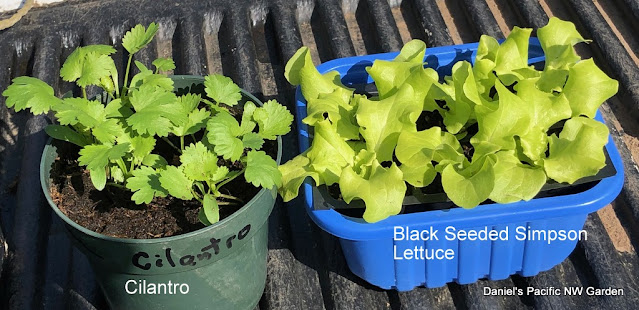Last year, the cooking tomato crop was great. There were lots of tasty excellent tomatoes. They ripened over a few weeks, so I was able to process them for freezing in a few batches.
The slicing tomatoes did not do so well. There were only a few, mainly on the variety 'Early Girl".
The cherry tomatoes were late, and a lot of them split and rotted before we could eat them. They also tended to come all at once.
This year, I decided on several goals. Unfortunately, those goals have evolved, and I don't have the plants in the ground yet.
Image: Vintage image of seed packet, Livingston's Seeds. 100 years old.
With the pandemic, I thought the seed prices went up, shipping and handling went up, and availability went down. So one thing I wanted to do was see what varieties I can save my old seeds from.
I still want to try some hybrids, which I think have potential for better disease resistance.
I want to try some with potential for growing in our climate, which tends to be cooler than a lot of tomato country. The midwest, for example, is hotter, hotter nights, longer season, and more humid. Looking at historic varieties, I thought Russian types might tolerate this climate and have potential for seed saving because they are not hybrids.
So the goals were:
Some Russian historic types, for saving seeds and possible better in this climate.
Some hybrids as a backup. Especially, my two favorites, Better Boy and Lemon Boy.
Different choices for cherry tomatoes.
Another more than 100 year old seed packet.
For the sauce tomatoes, I also want to try some to see if I can save seeds, but have back up hybrids in case those historic types don't do well. So I planted seeds for:
la Roma III Hybrid multi disease resistant, 76 days to maturity, determinate.
I didn't think to check for determinate types. Determinate means they all ripen at once, which I want, and don't grow extremely tall and need tying up to tall posts. Unfortunately, I got
Amish Paste - which on further reading is not determinate, not even necessarily a paste tomato, so why is it called that? I planted a six pack but I think I'll just keep one plant to try. 85 days.
Tyren F1 hybrid - a Marzano type, but a hybrid, multi disease resistant, 75 days, indeterminate. There's that indeterminate again, and I didn't check. Again, maybe I'll just grow one plant from the 6 pack. I don't really have room for a lot if they are not what I wanted.
So, I decided to order some of the old type Roma, which is heirloom, so I can save seeds; determinate so I can harvest all in a narrow window of time and they don't grow so tall. I think I'll just grow a couple, and use the La Roma III as my main past tomato, and grow a couple of Roma and see how they do and save seeds.
OK, now more overthinking. I started looking into dwarf tomatoes. Dwarf tomato plants have a mutation in the gene for stem length. They can be all sizes, colors, and types but grow a lot shorter. I have never tried them. Most if not all of the new varieties were developed by amateur tomato growers using a dwarf parent and various heirloom tomato parents. Dwarf Tomato Project. Most tomatoes grow very tall, need to be tied to tall posts, and take a lot of maintenance. The dwarf types might need a post, but apparently do all of their growing on a lot shorter stems. They are also considered stable, not hybrid, so a home grower can save seeds. The heights range usually range from 2 to 4 1/2 feet tall. Much better for me in the future if they work out. I decided to experiment. There is still time to start tomato seeds - I usually start them mid April - so I ordered from Victory Seeds. Victory has a lot of non-corporate type seeds, historic or open pollinated types, and nice descriptions. The seeds shipped quickly. I can start them today.

Here are the choices I made, and the available info. Some are older varieties, not from the Dwarf Tomato Project (DTP).
Alpatieva 905-A. 65 days. An old Soviet Russian variety, about 1950. Very small plant, 18 to 24 inches tall. Red 2 to 5 ounce tomatoes. Might be nice in containers.
Extreme Bush. 50 days. An old seed catalog (Gleckler, 1958) variety. 12-28 inches tall. Red. These might be nice in containers, or raised bed. Plant size more like peppers or eggplants.
Dwarf Johnson Cherry. 65 days. "Dwarf". "Very Prolific". Cherry, pink (look red to my eyes).
Dwarf Champion Improved. 85 Days. Apparently an improvement of Dwarf Champion which was introduced by Maule's Seed company in 1889 and later carried by Livingston Seeds. Pink 3-5 oz tomatoes (again to my eyes they look red in the image).
Brandy Fred. 10-16 oz tomatoes, purple. A hybrid with Brandywine.
Tanuda Red. 75 days. Red.
Dwarf CC McGee. "late season". 4-8 oz, "Ivory" (look yellow to my eyes).
Clare Valley Pink. 84 days. Small to medium size pink tomato (look red to my eyes).
So that's all my overthinking tomatoes. Most of the dwarf types will be in containers or in small spots in the garden. I didn't intend to add more tomato plants, but these are a nice experiment for future gardening and for saving my own seeds if they do well for me and are tasty.


















